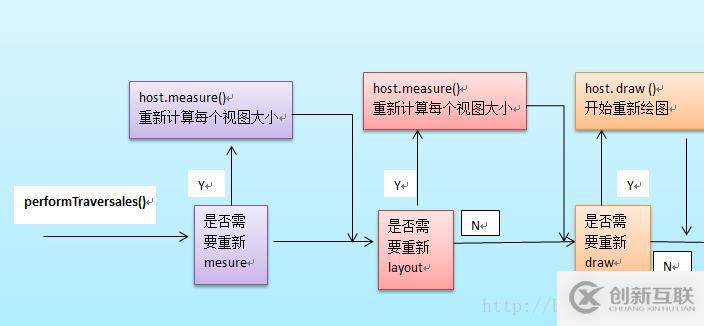Android中View绘制流程的示例分析-创新互联
这篇文章主要介绍了Android中View绘制流程的示例分析,具有一定借鉴价值,感兴趣的朋友可以参考下,希望大家阅读完这篇文章之后大有收获,下面让小编带着大家一起了解一下。

创建Window
Window即窗口,这个概念在AndroidFramework中的实现为android.view.Window这个抽象类,这个抽象类是对Android系统中的窗口的抽象。在介绍这个类之前,我们先来看看究竟什么是窗口呢?
实际上,窗口是一个宏观的思想,它是屏幕上用于绘制各种UI元素及响应用户输入事件的一个矩形区域。通常具备以下两个特点:
独立绘制,不与其它界面相互影响;
不会触发其它界面的输入事件;
在Android系统中,窗口是独占一个Surface实例的显示区域,每个窗口的Surface由WindowManagerService分配。我们可以把Surface看作一块画布,应用可以通过Canvas或OpenGL在其上面作画。画好之后,通过SurfaceFlinger将多块Surface按照特定的顺序(即Z-order)进行混合,而后输出到FrameBuffer中,这样用户界面就得以显示。
android.view.Window这个抽象类可以看做Android中对窗口这一宏观概念所做的约定,而PhoneWindow这个类是Framework为我们提供的Android窗口概念的具体实现。接下来我们先来介绍一下android.view.Window这个抽象类。
这个抽象类包含了三个核心组件:
WindowManager.LayoutParams:窗口的布局参数;
Callback:窗口的回调接口,通常由Activity实现;
ViewTree:窗口所承载的控件树。
在Activity的attach方法中通过调用PolicyManager.makeNewWindo创建Window,将一个View add到WindowManager时,WindowManagerImpl创建一个ViewRoot来管理该窗口的根View。并通过ViewRoot.setView方法把该View传给ViewRoot。
final void attach(Context context, ActivityThread aThread,
Instrumentation instr, IBinder token, int ident,
Application application, Intent intent, ActivityInfo info,
CharSequence title, Activity parent, String id,
NonConfigurationInstances lastNonConfigurationInstances,
Configuration config) {
attachBaseContext(context);
mFragments.attachActivity(this, mContainer, null);
mWindow = PolicyManager.makeNewWindow(this);
mWindow.setCallback(this);
mWindow.getLayoutInflater().setPrivateFactory(this);创建DecorView
DecorView为整个Window界面的最顶层View。
Activity中的Window对象帮我们创建了一个PhoneWindow内部类DecorView(父类为FrameLayout)窗口顶层视图,然后通过LayoutInflater将xml内容布局解析成View树形结构添加到DecorView顶层视图中id为content的FrameLayout父容器上面。Activity的content内容布局最终会添加到DecorView窗口顶层视图上面。
protected boolean initializePanelDecor(PanelFeatureState st) {
st.decorView = new DecorView(getContext(), st.featureId);
st.gravity = Gravity.CENTER | Gravity.BOTTOM;
st.setStyle(getContext());
return true;
}创建ViewRoot并关联View
WindowManagerImpl保存DecorView到mViews,创建对应的ViewRoot;
ViewRoot用于管理窗口的根View,并和global window manger进行交互。ViewRoot中有一个nested class: W,W是一个Binder子类,用于接收global window manager的各种消息, 如按键消息, 触摸消息等。 ViewRoot有一个W类型的成员mWindow,ViewRoot在Constructor中创建一个W的instance并赋值给mWindow。 ViewRoot是Handler的子类, W会通过Looper把消息传递给ViewRoot。 ViewRoot在setView方法中把mWindow传给sWindowSession。
public void addView(View view, ViewGroup.LayoutParams params,
Display display, Window parentWindow) {
if (view == null) {
throw new IllegalArgumentException("view must not be null");
}
if (display == null) {
throw new IllegalArgumentException("display must not be null");
}
if (!(params instanceof WindowManager.LayoutParams)) {
throw new IllegalArgumentException("Params must be WindowManager.LayoutParams");
}
final WindowManager.LayoutParams wparams = (WindowManager.LayoutParams)params;
if (parentWindow != null) {
parentWindow.adjustLayoutParamsForSubWindow(wparams);
}
ViewRootImpl root;
View panelParentView = null;
synchronized (mLock) {
// Start watching for system property changes.
if (mSystemPropertyUpdater == null) {
mSystemPropertyUpdater = new Runnable() {
@Override public void run() {
synchronized (mLock) {
for (ViewRootImpl viewRoot : mRoots) {
viewRoot.loadSystemProperties();
}
}
}
};
SystemProperties.addChangeCallback(mSystemPropertyUpdater);
}
int index = findViewLocked(view, false);
if (index >= 0) {
throw new IllegalStateException("View " + view
+ " has already been added to the window manager.");
}
// If this is a panel window, then find the window it is being
// attached to for future reference.
if (wparams.type >= WindowManager.LayoutParams.FIRST_SUB_WINDOW &&
wparams.type <= WindowManager.LayoutParams.LAST_SUB_WINDOW) {
final int count = mViews != null ? mViews.length : 0;
for (int i=0; i<count; i++) {
if (mRoots[i].mWindow.asBinder() == wparams.token) {
panelParentView = mViews[i];
}
}
}
root = new ViewRootImpl(view.getContext(), display);
view.setLayoutParams(wparams);
if (mViews == null) {
index = 1;
mViews = new View[1];
mRoots = new ViewRootImpl[1];
mParams = new WindowManager.LayoutParams[1];
} else {
index = mViews.length + 1;
Object[] old = mViews;
mViews = new View[index];
System.arraycopy(old, 0, mViews, 0, index-1);
old = mRoots;
mRoots = new ViewRootImpl[index];
System.arraycopy(old, 0, mRoots, 0, index-1);
old = mParams;
mParams = new WindowManager.LayoutParams[index];
System.arraycopy(old, 0, mParams, 0, index-1);
}
index--;
mViews[index] = view;
mRoots[index] = root;
mParams[index] = wparams;
}
// do this last because it fires off messages to start doing things
try {
root.setView(view, wparams, panelParentView);
} catch (RuntimeException e) {
// BadTokenException or InvalidDisplayException, clean up.
synchronized (mLock) {
final int index = findViewLocked(view, false);
if (index >= 0) {
removeViewLocked(index, true);
}
}
throw e;
}
}ViewRoot是GUI管理系统与GUI呈现系统之间的桥梁,需要注意它并不是一个View类型,。
它的主要作用如下:
1、向DecorView分发收到的用户发起的event事件,如按键,触屏,轨迹球等事件;
2、与WindowManagerService交互,完成整个Activity的GUI的绘制。
View绘制基本流程
这里先给出Android系统View的绘制流程:依次执行View类里面的如下三个方法:
measure(int ,int) :测量View的大小
layout(int ,int ,int ,int) :设置子View的位置
draw(Canvas) :绘制View内容到Canvas画布上

整个View树的绘图流程是在ViewRoot.java类的performTraversals()函数展开的,该函数做的执行过程可简单概况为根据之前设置的状态,判断是否需要重新计算视图大小(measure)、是否重新需要安置视图的位置(layout)、以及是否需要重绘 (draw)
mesarue()测量过程
主要作用:为整个View树计算实际的大小,即设置实际的高(mMeasuredHeight)和宽(mMeasureWidth),每个View的控件的实际宽高都是由父视图和本身视图决定的。
具体的调用如下:
ViewRootImpl 的performTraversals方法中,调用measureHierarchy,然后调用performMeasure
private void performMeasure(int childWidthMeasureSpec, int childHeightMeasureSpec) {
Trace.traceBegin(Trace.TRACE_TAG_VIEW, "measure");
try {
mView.measure(childWidthMeasureSpec, childHeightMeasureSpec);
} finally {
Trace.traceEnd(Trace.TRACE_TAG_VIEW);
}
}ViewRoot根对象地属性mView(其类型一般为ViewGroup类型)调用measure()方法去计算View树的大小,回调
View/ViewGroup对象的onMeasure()方法,该方法实现的功能如下:
1、设置本View视图的最终大小,该功能的实现通过调用setMeasuredDimension()方法去设置实际的高(mMeasuredHeight)和宽(mMeasureWidth)
2、如果该View对象是个ViewGroup类型,需要重写onMeasure()方法,对其子视图进行遍历的measure()过程。
对每个子视图的measure()过程,是通过调用父类ViewGroup.java类里的measureChildWithMargins()方法去实现,该方法内部只是简单地调用了View对象的measure()方法。
整个measure调用流程就是个树形的递归过程
measure()方法两个参数都是父View传递过来的,也就是代表了父view的规格。他由两部分组成,高2位表示MODE,定义在MeasureSpec类(View的内部类)中,有三种类型,MeasureSpec.EXACTLY表示确定大小,MeasureSpec.AT_MOST表示大大小,MeasureSpec.UNSPECIFIED不确定。低30位表示size,也就是父View的大小。对于系统Window类的DecorVIew对象Mode一般都为MeasureSpec.EXACTLY,而size分别对应屏幕宽高。对于子View来说大小是由父View和子View共同决定的。
protected void onMeasure(int widthMeasureSpec, int heightMeasureSpec) {
setMeasuredDimension(getDefaultSize(getSuggestedMinimumWidth(), widthMeasureSpec),
getDefaultSize(getSuggestedMinimumHeight(), heightMeasureSpec));
}protected final void setMeasuredDimension(int measuredWidth, int measuredHeight) {
boolean optical = isLayoutModeOptical(this);
if (optical != isLayoutModeOptical(mParent)) {
Insets insets = getOpticalInsets();
int opticalWidth = insets.left + insets.right;
int opticalHeight = insets.top + insets.bottom;
measuredWidth += optical ? opticalWidth : -opticalWidth;
measuredHeight += optical ? opticalHeight : -opticalHeight;
}
mMeasuredWidth = measuredWidth;
mMeasuredHeight = measuredHeight;
mPrivateFlags |= PFLAG_MEASURED_DIMENSION_SET;
}layout布局过程
主要作用 :为将整个根据子视图的大小以及布局参数将View树放到合适的位置上。
具体的调用如下:
ViewRootImpl 的performTraversals方法中,调用performLayout
private void performLayout(WindowManager.LayoutParams lp, int desiredWindowWidth,
int desiredWindowHeight) {
mLayoutRequested = false;
mScrollMayChange = true;
mInLayout = true;
final View host = mView;
if (DEBUG_ORIENTATION || DEBUG_LAYOUT) {
Log.v(TAG, "Laying out " + host + " to (" +
host.getMeasuredWidth() + ", " + host.getMeasuredHeight() + ")");
}
Trace.traceBegin(Trace.TRACE_TAG_VIEW, "layout");
try {
host.layout(0, 0, host.getMeasuredWidth(), host.getMeasuredHeight());
mInLayout = false;
int numViewsRequestingLayout = mLayoutRequesters.size();
if (numViewsRequestingLayout > 0) {
// requestLayout() was called during layout.
// If no layout-request flags are set on the requesting views, there is no problem.
// If some requests are still pending, then we need to clear those flags and do
// a full request/measure/layout pass to handle this situation.
ArrayList<View> validLayoutRequesters = getValidLayoutRequesters(mLayoutRequesters,
false);
if (validLayoutRequesters != null) {
// Set this flag to indicate that any further requests are happening during
// the second pass, which may result in posting those requests to the next
// frame instead
mHandlingLayoutInLayoutRequest = true;
// Process fresh layout requests, then measure and layout
int numValidRequests = validLayoutRequesters.size();
for (int i = 0; i < numValidRequests; ++i) {
final View view = validLayoutRequesters.get(i);
Log.w("View", "requestLayout() improperly called by " + view +
" during layout: running second layout pass");
view.requestLayout();
}
measureHierarchy(host, lp, mView.getContext().getResources(),
desiredWindowWidth, desiredWindowHeight);
mInLayout = true;
host.layout(0, 0, host.getMeasuredWidth(), host.getMeasuredHeight());
mHandlingLayoutInLayoutRequest = false;
// Check the valid requests again, this time without checking/clearing the
// layout flags, since requests happening during the second pass get noop'd
validLayoutRequesters = getValidLayoutRequesters(mLayoutRequesters, true);
if (validLayoutRequesters != null) {
final ArrayList<View> finalRequesters = validLayoutRequesters;
// Post second-pass requests to the next frame
getRunQueue().post(new Runnable() {
@Override
public void run() {
int numValidRequests = finalRequesters.size();
for (int i = 0; i < numValidRequests; ++i) {
final View view = finalRequesters.get(i);
Log.w("View", "requestLayout() improperly called by " + view +
" during second layout pass: posting in next frame");
view.requestLayout();
}
}
});
}
}
}
} finally {
Trace.traceEnd(Trace.TRACE_TAG_VIEW);
}
mInLayout = false;
}host.layout()开始View树的布局,继而回调给View/ViewGroup类中的layout()方法。具体流程如下
1 、layout方法会设置该View视图位于父视图的坐标轴,即mLeft,mTop,mLeft,mBottom(调用setFrame()函数去实现),接下来回调onLayout()方法(如果该View是ViewGroup对象,需要实现该方法,对每个子视图进行布局)。
2、如果该View是个ViewGroup类型,需要遍历每个子视图chiildView,调用该子视图的layout()方法去设置它的坐标值。
protected void onLayout(boolean changed, int left, int top, int right, int bottom) {
}public void layout(int l, int t, int r, int b) {
int oldL = mLeft;
int oldT = mTop;
int oldB = mBottom;
int oldR = mRight;
boolean changed = isLayoutModeOptical(mParent) ?
setOpticalFrame(l, t, r, b) : setFrame(l, t, r, b);
if (changed || (mPrivateFlags & PFLAG_LAYOUT_REQUIRED) == PFLAG_LAYOUT_REQUIRED) {
onLayout(changed, l, t, r, b);
mPrivateFlags &= ~PFLAG_LAYOUT_REQUIRED;
ListenerInfo li = mListenerInfo;
if (li != null && li.mOnLayoutChangeListeners != null) {
ArrayList<OnLayoutChangeListener> listenersCopy =
(ArrayList<OnLayoutChangeListener>)li.mOnLayoutChangeListeners.clone();
int numListeners = listenersCopy.size();
for (int i = 0; i < numListeners; ++i) {
listenersCopy.get(i).onLayoutChange(this, l, t, r, b, oldL, oldT, oldR, oldB);
}
}
}
mPrivateFlags &= ~PFLAG_FORCE_LAYOUT;
}draw()绘图过程
ViewRootImpl的performTraversals方法中,调用了mView的draw方法
mView.draw()开始绘制,draw()方法实现的功能如下:
1、绘制该View的背景
2、为显示渐变框做一些准备操作
3、调用onDraw()方法绘制视图本身(每个View都需要重载该方法,ViewGroup不需要实现该方法)
4、调用dispatchDraw()方法绘制子视图(如果该View类型不为ViewGroup,即不包含子视图,不需要重载该方法)
值得说明的是,ViewGroup类已经为我们重写了dispatchDraw()的功能实现,应用程序一般不需要重写该方法,但可以重载父类函数实现具体的功能。
dispatchDraw()方法内部会遍历每个子视图,调用drawChild()去重新回调每个子视图的draw()方法。
5、绘制滚动条
刷新视图
Android中实现view的更新有两个方法,一个是invalidate,另一个是postInvalidate,其中前者是在UI线程自身中使用,而后者在非UI线程中使用。
requestLayout()方法:会导致调用measure()过程和layout()过程。
说明:只是对View树重新布局layout过程包括measure()和layout()过程,不会调用draw()过程,但不会重新绘制
任何视图包括该调用者本身。
一般引起invalidate()操作的函数如下:
1、直接调用invalidate()方法,请求重新draw(),但只会绘制调用者本身。
2、setSelection()方法:请求重新draw(),但只会绘制调用者本身。
3、setVisibility()方法:当View可视状态在INVISIBLE转换VISIBLE时,会间接调用invalidate()方法,继而绘制该View。
4、setEnabled()方法:请求重新draw(),但不会重新绘制任何视图包括该调用者本身。
Android是什么Android是一种基于Linux内核的自由及开放源代码的操作系统,主要使用于移动设备,如智能手机和平板电脑,由美国Google公司和开放手机联盟领导及开发。
感谢你能够认真阅读完这篇文章,希望小编分享的“Android中View绘制流程的示例分析”这篇文章对大家有帮助,同时也希望大家多多支持创新互联,关注创新互联行业资讯频道,更多相关知识等着你来学习!
本文题目:Android中View绘制流程的示例分析-创新互联
分享链接:https://www.cdcxhl.com/article14/ddicge.html
成都网站建设公司_创新互联,为您提供网页设计公司、网站改版、营销型网站建设、App开发、网站制作、外贸网站建设
声明:本网站发布的内容(图片、视频和文字)以用户投稿、用户转载内容为主,如果涉及侵权请尽快告知,我们将会在第一时间删除。文章观点不代表本网站立场,如需处理请联系客服。电话:028-86922220;邮箱:631063699@qq.com。内容未经允许不得转载,或转载时需注明来源: 创新互联

- 国内虚拟主机哪个好 2023-07-20
- H5网站开发——创新互联 2021-04-26
- 网站打开速度优化该从哪些方面下手 2022-11-18
- 制作网页的开支都有哪些方面 2023-02-21
- 枣庄信息推广聊城网站推广整站优化时需要阐明哪些因素? 2023-02-06
- 手机网站建设的五大要点 2022-12-11
- seo适度优化的“度”怎么把握 2021-09-26
- 解析网站四大链接之间的关系 2021-05-09
- 成都网站优化之浅谈什么是SEO中的蜘蛛池,及作用弊端 2023-07-03
- 北京网站建设如何进行视觉设计? 2023-08-31
- 自己建设网站有什么步骤? 2022-12-15
- 增加网站流量所要注意的那些 2016-11-01